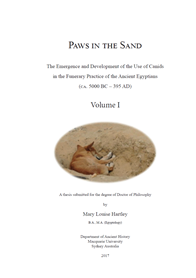
This research investigates the nature and scope of the inclusion of canids/dogs in the funerary practice of the ancient Egyptians. Canids used in a mortuary context are well known, due mainly to the use of canids in the later votive context. However, the first documented evidence of actual burials of canids/dogs occurred during the Predynastic Period, and it is this aspect that is the focus for this research. Where did the concept of burying a canid/dog originate, and why? And did the practice evolve over time to morph into the later votive practice? This research employs the use of history, archaeology and physical anthropology to present an analysis for the significance of a canid/dog burial, and to trace the evolution of the practice through time.
This research is based on a sample of 141 canid/dog burials derived from available archaeological data from the Predynastic to the Graeco-Roman Periods (ca. 5300 BC–AD 395). Additionally, a case study of 119 votive canid crania found at Saqqara, will provide data for the analysis regarding the use of canids in a votive capacity. The majority of canid/dog burials were observed in the Predynastic Period, therefore this period is significant to theunderstanding of how, when, and why this practice first began. Things do not ‘just happen’ without reason, and the historical iconographical evidence surrounding canids, particularly the dog, found in early communities provides an insight into how canids were perceived in society, which in turn provides a portal into the beginnings of the practice. Chronologically, canid/dog burials continued from the Predynastic Period, albeit somewhat sporadically, through to the Late Period, when a resurgence of the practice is observed. It is also during the Late Period that a marked rise in the use of votive canids linked to the Cult of Anubis begins. Burying a canid/dog in a funerary context, and offering a votive canid in a religious context, ran concurrently throughout the Late Period and into the Graeco-Roman Period, with the votive practice increasing considerably and becoming the preferred method for the general population to gain access to the god Anubis.
Quantitative and qualitative data analysis presented in this thesis identifies canid/dog burials in the archaeological record from the Predynastic to the Graeco-Roman Periods, confirming and interpreting their role within the funerary process. This research concludes that the common thread binding the presence of the canid in the funerary practice consistently demonstrates a protective function.

